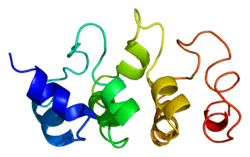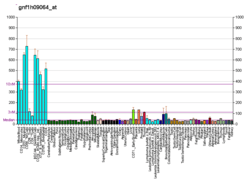MTPN
Myotrophin is a protein that in humans is encoded by the MTPN gene.[5][6]
Interactions
MTPN has been shown to interact with RELA[7] and REL.[7]
gollark: It also blots out the sun, partly.
gollark: Heav thinks that rifts spawn on the highest available land, which seems right, so we think this should redirect rift spawns to an easy-to-clean area.
gollark: <@151391317740486657> Check out the giant sky shield!
gollark: We don't need it though. At all.
gollark: AS has "shooting stars". I don't know what they do.
References
- GRCh38: Ensembl release 89: ENSG00000105887 - Ensembl, May 2017
- GRCm38: Ensembl release 89: ENSMUSG00000029840 - Ensembl, May 2017
- "Human PubMed Reference:". National Center for Biotechnology Information, U.S. National Library of Medicine.
- "Mouse PubMed Reference:". National Center for Biotechnology Information, U.S. National Library of Medicine.
- Mitra S, Timur AA, Gupta S, Wang Q, Sen S (July 2001). "Assignment of myotrophin to human chromosome band 7q33→q35 by in situ hybridization". Cytogenet Cell Genet. 93 (1–2): 151–2. doi:10.1159/000056974. PMID 11474205.
- "Entrez Gene: MTPN myotrophin".
- Knuefermann, Pascal; Chen Peter; Misra Arunima; Shi Shu-Ping; Abdellatif Maha; Sivasubramanian Natarajan (June 2002). "Myotrophin/V-1, a protein up-regulated in the failing human heart and in postnatal cerebellum, converts NFkappa B p50-p65 heterodimers to p50-p50 and p65-p65 homodimers". J. Biol. Chem. United States. 277 (26): 23888–97. doi:10.1074/jbc.M202937200. ISSN 0021-9258. PMID 11971907.
Further reading
- Taoka M, Yamakuni T, Song SY, et al. (1992). "A rat cerebellar protein containing the cdc10/SWI6 motif". Eur. J. Biochem. 207 (2): 615–20. doi:10.1111/j.1432-1033.1992.tb17088.x. PMID 1633812.
- Sil P, Misono K, Sen S (1993). "Myotrophin in human cardiomyopathic heart". Circ. Res. 73 (1): 98–108. doi:10.1161/01.res.73.1.98. PMID 8508536.
- Sivasubramanian N, Adhikary G, Sil PC, Sen S (1996). "Cardiac myotrophin exhibits rel/NF-kappa B interacting activity in vitro". J. Biol. Chem. 271 (5): 2812–6. doi:10.1074/jbc.271.5.2812. PMID 8576259.
- Anderson KM, Berrebi-Bertrand I, Kirkpatrick RB, et al. (1999). "cDNA sequence and characterization of the gene that encodes human myotrophin/V-1 protein, a mediator of cardiac hypertrophy". J. Mol. Cell. Cardiol. 31 (4): 705–19. doi:10.1006/jmcc.1998.0903. PMID 10329199.
- Hartley JL, Temple GF, Brasch MA (2001). "DNA Cloning Using In Vitro Site-Specific Recombination". Genome Res. 10 (11): 1788–95. doi:10.1101/gr.143000. PMC 310948. PMID 11076863.
- Wiemann S, Weil B, Wellenreuther R, et al. (2001). "Toward a Catalog of Human Genes and Proteins: Sequencing and Analysis of 500 Novel Complete Protein Coding Human cDNAs". Genome Res. 11 (3): 422–35. doi:10.1101/gr.GR1547R. PMC 311072. PMID 11230166.
- Simpson JC, Wellenreuther R, Poustka A, et al. (2001). "Systematic subcellular localization of novel proteins identified by large-scale cDNA sequencing". EMBO Rep. 1 (3): 287–92. doi:10.1093/embo-reports/kvd058. PMC 1083732. PMID 11256614.
- Knuefermann P, Chen P, Misra A, et al. (2002). "Myotrophin/V-1, a protein up-regulated in the failing human heart and in postnatal cerebellum, converts NFkappa B p50-p65 heterodimers to p50-p50 and p65-p65 homodimers". J. Biol. Chem. 277 (26): 23888–97. doi:10.1074/jbc.M202937200. PMID 11971907.
- Gupta S, Sen S (2002). "Myotrophin-kappaB DNA interaction in the initiation process of cardiac hypertrophy". Biochim. Biophys. Acta. 1589 (3): 247–60. doi:10.1016/S0167-4889(02)00178-7. PMID 12031792.
- Strausberg RL, Feingold EA, Grouse LH, et al. (2003). "Generation and initial analysis of more than 15,000 full-length human and mouse cDNA sequences". Proc. Natl. Acad. Sci. U.S.A. 99 (26): 16899–903. Bibcode:2002PNAS...9916899M. doi:10.1073/pnas.242603899. PMC 139241. PMID 12477932.
- Scherer SW, Cheung J, MacDonald JR, et al. (2003). "Human Chromosome 7: DNA Sequence and Biology". Science. 300 (5620): 767–72. Bibcode:2003Sci...300..767S. doi:10.1126/science.1083423. PMC 2882961. PMID 12690205.
- Hillier LW, Fulton RS, Fulton LA, et al. (2003). "The DNA sequence of human chromosome 7". Nature. 424 (6945): 157–64. Bibcode:2003Natur.424..157H. doi:10.1038/nature01782. PMID 12853948.
- Ota T, Suzuki Y, Nishikawa T, et al. (2004). "Complete sequencing and characterization of 21,243 full-length human cDNAs". Nat. Genet. 36 (1): 40–5. doi:10.1038/ng1285. PMID 14702039.
- Gerhard DS, Wagner L, Feingold EA, et al. (2004). "The Status, Quality, and Expansion of the NIH Full-Length cDNA Project: The Mammalian Gene Collection (MGC)". Genome Res. 14 (10B): 2121–7. doi:10.1101/gr.2596504. PMC 528928. PMID 15489334.
- Wiemann S, Arlt D, Huber W, et al. (2004). "From ORFeome to Biology: A Functional Genomics Pipeline". Genome Res. 14 (10B): 2136–44. doi:10.1101/gr.2576704. PMC 528930. PMID 15489336.
- Mehrle A, Rosenfelder H, Schupp I, et al. (2006). "The LIFEdb database in 2006". Nucleic Acids Res. 34 (Database issue): D415–8. doi:10.1093/nar/gkj139. PMC 1347501. PMID 16381901.
- Xiong Z, Liu E, Yan Y, et al. (2006). "An unconventional antigen translated by a novel internal ribosome entry site elicits antitumor humoral immune reactions". J. Immunol. 177 (7): 4907–16. doi:10.4049/jimmunol.177.7.4907. PMC 3902139. PMID 16982933.
- Ewing RM, Chu P, Elisma F, et al. (2007). "Large-scale mapping of human protein–protein interactions by mass spectrometry". Mol. Syst. Biol. 3 (1): 89. doi:10.1038/msb4100134. PMC 1847948. PMID 17353931.
This article is issued from Wikipedia. The text is licensed under Creative Commons - Attribution - Sharealike. Additional terms may apply for the media files.







